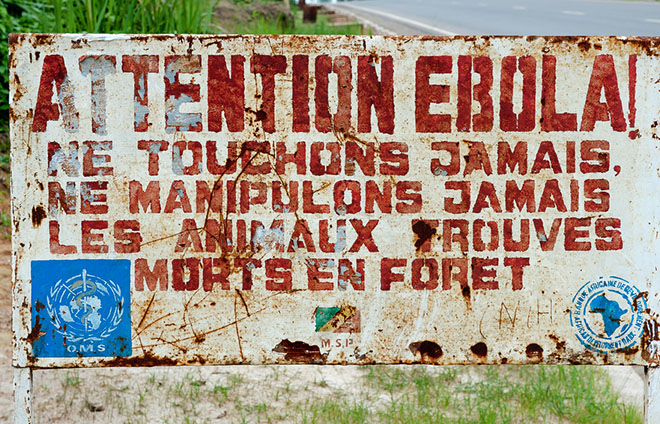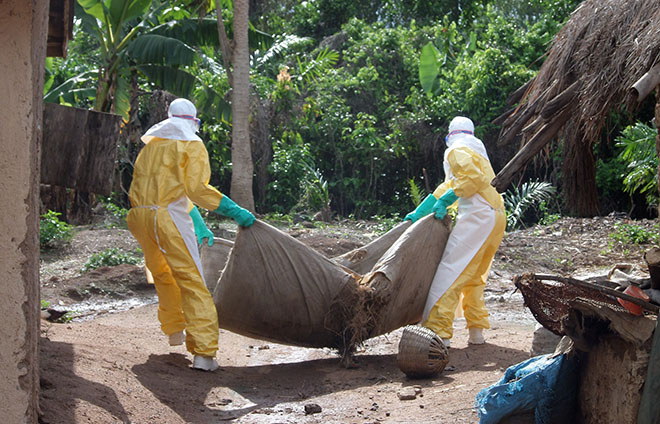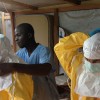In sixth grade, I molded a human hand out of clay and then used acrylic paints to map the course of radiation poisoning. When a seventh-grade science teacher told us to create models of animal cells, mine had to be three-dimensional. I bought a fishbowl and some clear Jell-O. Over the course of an afternoon and night, I tiptoed into the kitchen every hour or two to pour a thin layer of gelatin onto my legume and pasta organelles.
By eighth grade, I had moved on to viruses, becoming fascinated with the least-understood and most terrifying group known to man: viral hemorrhagic fevers, the genre that claims yellow fever, dengue fever, and the Marburg and Ebola viruses. I learned that Ebola isn’t a scary virus—it’s the scary virus. Yellow fever may have wiped out more than 10 percent of Philadelphia’s population in 1793, but that stunning death toll is nothing compared to the devastation that Marburg and Ebola wreak. They’re our epidemiological boogeymen.
What Ebola does to the human body defies reason. It’s like something out of a horror movie, not a textbook. A la Andromeda Strain, we know very little about where this virus comes from, just that the most likely “ground zero” is the fruit bat. These bats serve as natural reservoirs, occasionally infecting other animals—from primates to antelopes, porcupines, rodents, dogs, and pigs. Most strains that can infect humans are extremely contagious and exceedingly lethal, with fatality rates between 60 and 90 percent.
IN 1994, RICHARD PRESTON, the New Yorker contributor who has written a number of books about infectious disease, commented, “Ebola does in 10 days what it takes AIDS 10 years to accomplish.”
At the least, this is the most virulent and efficient strain of Ebola we’ve ever seen. At worst, we’re witnessing the onset of a deadly mutation anticipated and feared for almost four decades.
Two hundred and eighty of the 318 people who contracted the virus died during the first known Ebola outbreak in what’s now the Democratic Republic of the Congo in 1976. That’s an 88 percent fatality rate. The same year, a less virulent strain appeared in Sudan: 284 infected, 151 dead. It was 20 years before the next outbreak: In 1995, Ebola infected 315 and killed 250—a 77 percent fatality rate. From 1995 to 2012, the Centers for Disease Control and Prevention recorded a series of distinct Ebola epidemics in Gabon and the D.R.C. claiming 621 lives, their fatality rates roughly between 50 and 90 percent. A 2000 epidemic in Uganda killed more than half of the 425 people infected.
The early symptoms of Ebola are flu-like—a runny nose, chills. But then the virus begins to cause white blood cells to rupture and prevent blood from clotting. In the final stage of the disease, patients’ eyes turn red and their genitals swell. They likely have purpura, subcutaneous hemorrhaging, and appear bruised all over; sufferers can bleed from all orifices. Low blood pressure is what kills most victims.
All it takes to contract Ebola is to be in contact with an infected person or bodily fluids, even sweat or saliva. It can take up to three weeks for someone who’s been infected to begin to suffer symptoms, according to the World Health Organization. The CDC, working to control a panic, emphasized at its Monday press conference that sufferers may not be contagious until that point—but who hasn’t ignored flu-like symptoms and gone out in public?
Because of its infectiousness and long incubation period, and the banality of early symptoms, it can be difficult to track and contain Ebola. And we don’t know how to cure it. Perversely enough, the virus’ Achilles Heel is how “hot” it is, in the words of Preston. He writes that the Ebola strain that surfaced in Sudan in the 1970s may only have been contained because “it killed people so fast that they didn’t have much time to infect other people before they died.”
ONCE YOU KNOW WHAT Ebola looks like,allusions are everywhere. I read every scientific article I could get my hands on in 1998, scoured every one of Preston’s articles and books on viruses and biological weapons, beginning with 1994’s The Hot Zone. I watched and re-watched Outbreak and a half-dozen other epidemiological thrillers.
Horror plots involving viruses often incorporate many of the worst symptoms, not just for the shocking effect of seeing a victim bleeding in every conceivable way on screen but for the even more troubling punch of evoking a virus that isn’t at all fictional or supernatural, that really does exist. The Walking Dead and related programs are not really borrowing at all: Ebola patients and survivors are sometimes treated as real-life zombies.

A sign warns visitors that an area is infected with Ebola. (Photo: Sergey Uryadnikov/Shutterstock)
The scariest movies aren’t about things that could never, ever happen, after all. They’re about the worst things that could happen. And one of the worst things that could happen is happening right now. As of Thursday, the CDC put the total number of laboratory-confirmed cases of Ebola across Guinea, Liberia, and Sierra Leone at more than 900, and warned against travel to the area for any non-essential reasons. But more than 1,300 cases have been documented, according to the University of Minnesota Center for Infectious Disease Policy and Research. So far, according to Forbes, the fatality rate is about 56 percent.
The Ebola virus wreaking havoc in West Africa is a new strain. It first appeared in Guinea as early as December 2013 and has now spread to Liberia and Sierra Leone—three countries in which Ebola had never made an appearance until now. Nigeria may be next: Patrick Sawyer, a Liberia-born American citizen and consultant for the Liberian Ministry of Finance who had been caring for his sister in Liberia, arrived in Lagos on July 20, dying five days later.
The spread has been much quicker in this outbreak than others, affecting both urban and rural areas. The usual protective measures to prevent the spread of Ebola appear to have been less effective in this epidemic.
For example, while health care workers are always disproportionately represented among those affected by Ebola outbreaks, that’s usually because “health care workers are just trying to care for sick patients and don’t realize there is an increased risk,” said CDC representative Dr. Stephen Monroe in a press briefing.
What Ebola does to the human body defies reason. It’s like something out of a horror movie, not a textbook.
If that’s the case, how do we explain the deaths of Liberia’s Samuel Brisbane, who was a medical advisor of national prominence, and Sierra Leone’s Dr. Sheik Humarr Khan, an Ebola expert? A physician assistant and another physician, Dr. Nelson Korkor, were quarantined along with Brisbane. Initial coverage suggested all three had tested positive for Ebola. Three nurses working at the same treatment center as Khan are dead.
What about the infection of Texan Kent Brantly, who has been directing the Ebola clinic at the Eternal Love Winning Africa (ELWA) hospital where he worked in Monrovia, and North Carolinian colleague Nancy Writebol? Another four unnamed nurses in Suakoko, Liberia, are or were reportedly infected, although it’s not clear what training they had or at what point during the epidemic they contracted Ebola.
These infections could represent a normal rate of transmission for fully informed, trained health care workers during an outbreak. But in combination with the unprecedented scale of this epidemic, they may also suggest, at the least, that this is the most virulent and efficient strain of Ebola we’ve ever seen. At worst, we’re witnessing the onset of a deadly mutation anticipated and feared for almost four decades.
PERHAPS THE MOST-FEARED POTENTIAL Ebola mutation is efficient airborne transmission. Since at least the 1980s, epidemiologists have known it’s a possibility. Preston cited Gene Johnson’s 1986 experiment showing airborne transmission of both Ebola and Marburg between monkeys in The Hot Zone. More recently, airborne transmission between species has been documented in a laboratory setting. A BBC article on a recent study, published in Scientific Reports, suggested that airborne transmission could even have affected rates of contagion in some human outbreaks.
While the CDC has conceded that “all Ebola virus species have displayed the ability to be spread through airborne particles (aerosols) under research conditions,” its materials assert “this type of spread has not been documented among humans in a real-world setting, such as a hospital or household.” That’s not the same thing as saying it can’t happen, or that airborne transmission is not happening now.
At a Thursday press conference, CDC director Dr. Tom Frieden avoided claiming that this strain of Ebola is not airborne. Rebecca Hamman of Voice of Nigeria asked: “You just said the transmission of Ebola is through close contact. But it seems it’s going beyond that. The name itself was derived from a river. Do you mean the not water-borne or airborne?” She stated simply: “My people are scared at the rate at which it is being transmitted and moving very fast. I would like to know how Ebola is contracted.”

(Photo: European Commission DG ECHO/Flickr)
Frieden’s reply was not that Ebola is not airborne, but that it has not been “proven” to be airborne. He said, “Though there may be circumstances that it might have been spread through the air in situations like intubation of a patient, putting a breathing tube in them, that’s never been proven.”
On Friday I stumbled across a Facebook update from a visiting professor at the University of Liberia, John Berestecky. “The news from Monrovia is not good,” he begins. I was able to reach him by email on Saturday morning.
A microbiologist working at the University of Hawaii and teaching at Kapi’olani Community College, Berestecky first traveled to Liberia in 1979 for a three-year stint as a Peace Corps volunteer. He was assigned to the Liberia National Tuberculosis Control Programme, his main concerns tuberculosis and Hansen’s Disease. Months after Berestecky’s arrival, the Liberian government was overthrown in a coup. He returned in 1997 as an election observer, in time to see the election of former President Charles Taylor, now serving a 50-year sentence for war crimes.
In a country and region where many illnesses share the same initial symptoms as the early stages of the Ebola virus, “they don’t know how to differentiate this disease.”
Berestecky is now witnessing yet another historic, tragic moment in Liberia’s history. Last Saturday, he says, he “rode around town with a contact tracing team.” The team visited neighborhoods, attended “a meeting with a number of officials at the Ministry of Health,” and visited the ELWA hospital to interview a deceased patient’s husband.
According to Berestecky, there are just three contact tracing teams in Monrovia. The one he rode with last weekend was the only one in the field. “The other two were not operating because of one broken vehicle and the lack of fuel for the other vehicle,” his post notes, although there appeared to be “no shortage of operational government vehicles in the Ministry parking lot.”
Worse, says the professor, “I learned that day there was only one Case Investigation Team operating.” He explained, that’s the team sent to “investigate and classify all symptomatic patients and any suspicious dead bodies in the various communities of all of Monrovia.” The single team is “days behind in investigating reported cases.”
“I am trying to mobilize a group of students to become neighborhood information officers,” he writes. “I’m finding that the average person just really doesn’t seem to know what to do.” When people get sick, “they don’t know who to call.” When others get sick, “they don’t know how to respond to sick people.” And in a country and region where many illnesses share the same initial symptoms as the early stages of the Ebola virus, “they don’t know how to differentiate this disease.”
What the microbiologist knows of the spread of Ebola and Patrick Sawyer’s case in particular worries him. “This raises serious questions in my mind about the official mantra that only visibly ill patients and dead bodies are significant sources of contagion.”
I asked Berestecky by email how else he thought Ebola might be being spread. “I am not a clinician,” he told me, “nor do I have access to the primary epidemiology data so I wouldn’t really be in position to investigate or comment on that.”
“The mantra,” Berestecky says, “is that it is blood and body fluid transmissible.”
The CDC’s Monroe told those asking about the rate of infection among health care workers only that he “didn’t want to speculate.” He expressed confidence in “standard barrier nursing and infection control practices.” But surely if anyone could prevent transmission through these means, Sierra Leone’s top Ebola doctor, a leading Liberian internist, and the head of an Ebola clinic would have been able to do so. Instead, they became infected. Two of the three are now dead, and the third remains in serious condition.
Questions about how Ebola has spread in this outbreak are all the more critical as patients are airlifted to as of yet unaffected countries: Brantly is being treated at Atlanta’s Emory University Hospital and Writebol will join him next week. Even if this Ebola outbreak does not spread beyond West Africa, Frieden said that “even in a best case scenario, it could take three to six months or more” to stop the virus.

UPDATES
Why Aren’t Previously Successful Methods Used to Stop Ebola Working Against This New Strain?





